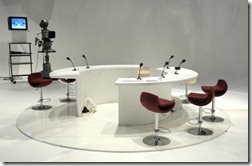Why You Should Never Watch Television
What’s the toughest television format for media spokespersons?
Is it the in-the-field “walk and talk?” The in-studio chat? The “bites” interview, during which the spokesperson looks slightly off-camera at the interviewer?
None of the above.
Most of our clients find the direct-to-camera, or “remote” interview, the toughest format of them all. Direct-to-camera interviews are challenging because the spokesperson usually sits alone in a studio – sometimes joined by few noisy crew members mulling around – as he or she stares into the lens, trying to pretend it’s a real person while ignoring distractions.
Most television stations unnecessarily make this difficult format even tougher for you. If you’ve ever done a straight-to-camera television interview, you’ve probably noticed that a television monitor is usually positioned nearby.
Sometimes, it’s just off to the side of the camera – at other times, it’s mounted directly beneath the camera.
The monitor is ostensibly there to help you, but there’s a problem: A “live” interview is never truly live, since it takes a fraction of a second to send the signal via satellite to its outgoing feed. That means the monitor showing your “live” interview will be a few frames behind, and you’re going to be distracted by your out-of-synch “lip flap” (named for the phenomenon of seeing your lips still moving after you’ve finished speaking).
Plus, there’s one other problem. Too many guests lose their eye contact with the lens and sneak a glance at the monitor instead.
So turn off the television. It’s going to distract you more than it helps you, and you don’t really need it.
Sure, that puts you at a slight disadvantage, since you won’t be able to see the host or the other guests. And if you’re an experienced media guest, you might experiment with keeping the monitor on – I concede that it’s nice to know if an opposing guest is shaking his head in disgust as you’re talking.
But for most spokespersons – the non-experts among us – the risk of a “live” monitor in our peripheral vision is too great a distraction. So ask the crew to turn it off before the interview begins.
Related: How to Gesture During a Television Interview
Related: How to Maintain Proper Posture During a Television Interview



